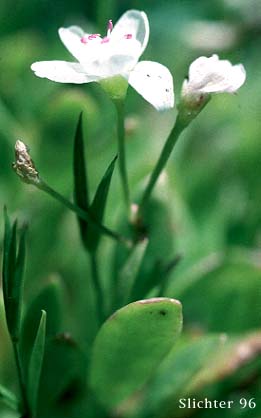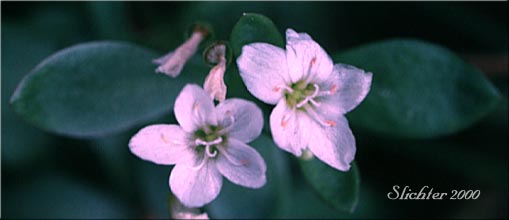 Photo
at right of Montia chamissoi from the headwaters of Degarmo Cr., Hart Mt.
National Antelope Refuge.........July 4, 1996.
Photo
at right of Montia chamissoi from the headwaters of Degarmo Cr., Hart Mt.
National Antelope Refuge.........July 4, 1996.
Water montia is a perennial with wide spreading rhizomes, with leafless stolons that root freely. The flower stems are erect, from 5-20 cm tall, and simple to branched. The leaves are opposite on the stems with several pairs of leaves present. Individual leaves are 2-5 cm long, oblanceolate to rhombic-obovate in shape, and from 5-17 mm wide. The leaves narrow gradually to a short petiole.
The inflorescence is a lax lax raceme arising from a leaf axil. 3-10 white or pink flowers are present. The 5 petals range from 5-8 mm long while the two green sepals are 2-3 mm long.
Water montia may be found in very moist places such as bogs or grassy wetlands and seeps and streamsides at low to medium elevation.
Water montia may be found from Alaska south to California (In the Pacific Northwest, it is found mostly east of the Cascades.) To the east, it may be found as far as Minnesota, Manitoba, Iowa, and south to New Mexico.
In the Columbia River Gorge, it may be found between the elevations of 200'-2000' between Bingen, WA and Stacker Butte in the east.
Like other members of this genus, water montia may be eaten either raw, in salads, or cooked.
